
Tuna fishing as described here is not a year-round sport. While yellowfin can be caught off of the Louisiana coast all year, October is special. After a couple of cold fronts, the hot-blooded fish come nearer to shore from their usual deep-water haunts.
During this period, the Fouquiers will fish at least 15 days.
“Nearer to shore” is a relative term. The closest the Fouquiers have ever found tuna off of Grand Isle is a little over 20 miles in 200 feet of water. The state record yellowfin that they caught was hauled from the water only 23 miles offshore.
While the tuna are close, the fishing is grand, but by early November it’s over as the fish return to their normal pattern further offshore. With exceptions, tuna fishermen then will travel as far as 130 to 180 miles offshore to fish semi-submersible oil platforms.
An exception to this pattern, noted Blake Fouquier, is during December and January, when yellowfin tuna will move within 50 miles of the mouth of the Mississippi River. Fishing hotspots include the Mars tension-leg oil platform in the Mississippi Canyon and the East Lumps east of the mouth of the river.
Historically, the greatest winter tuna hotspot was the “Midnight Lump,” more properly known as Sackett Bank. It is located just 23 miles southwest of the mouth of the Mississippi River’s Southwest Pass.
Between 2004 and 2007, seven of the top 10 yellowfin tuna in the Louisiana state records were pulled off the submerged mountain.
For unknown reasons, tuna fishing there has deteriorated dramatically.
